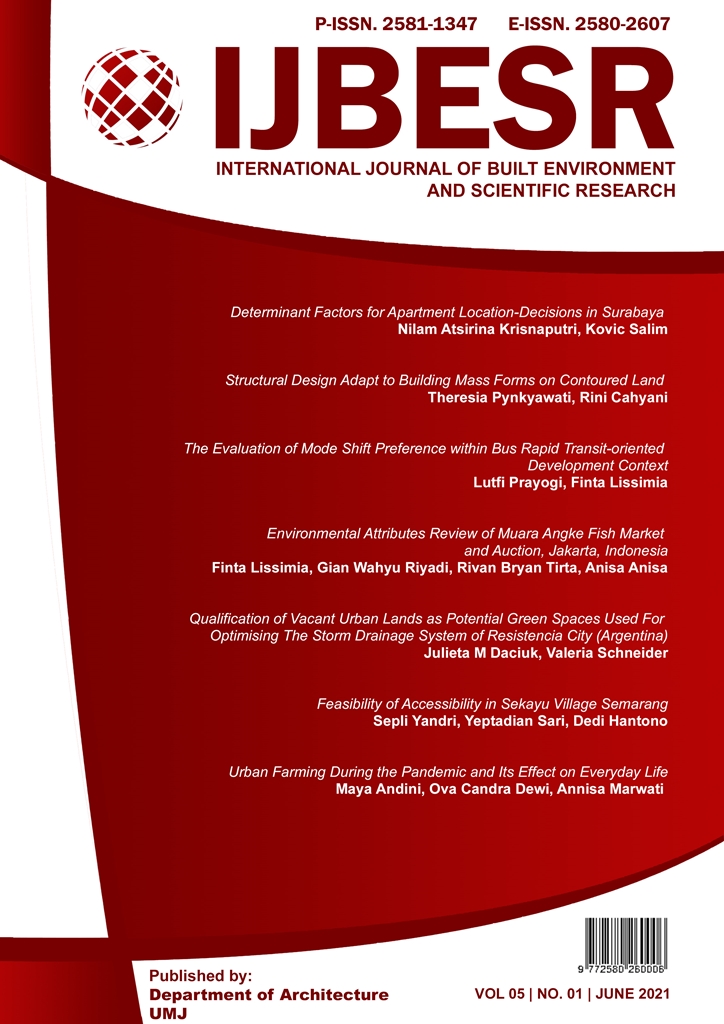The Evaluation of Mode Shift Preference within Bus Rapid Transit-oriented Development Context
DOI:
https://doi.org/10.24853/ijbesr.5.1.17-22Keywords:
Transit planningAbstract
Bus rapid transit (BRT) has been acknowledged as a mode of transit that is appropriate to be constructed in conjunction with transit-oriented development (TOD). In order to evaluate the occurrence of a TOD with BRT systems as its component, evaluating the passengers’ mode shift triggered by the provision of the BRT systems is one approach that can be taken. Within the mentioned type of TOD, the built environment should support, or even more trigger, the passengers’ mode shift into taking the BRT systems. This article evaluates the mode shift preference of Transjakarta BRT passengers. This article also evaluates the heterogeneity of mode shift preference among various groups of Transjakarta passengers. This article qualitatively describes the mode shift preference, while the data was collected, processed, and presented in quantitative manners. Information regarding the mode shift preference is collected through an indirect interview. The statistics of the mode shift preference is processed using simple statistical analysis and Bartlett’s test for variance heterogeneity. It is found that the role of the built environment in supporting Transjakarta passengers’ mode shift into taking Transjakarta is relatively low. It is also found that the variance of the mode shift preference is homogeneous across various groups of Transjakarta passengers. This article concludes that the envisioned bus rapid transit-oriented development (BRTOD) hasn't been fully occurring in areas around Transjakarta corridors.References
Cervero R. The transit metropolis: A global inquiry. Washington, United States: Island Press; 1998
Kamruzzaman M, Baker D, Washington S, Turrell G Advanced transit oriented development typology: Case study in Brisbane, Australia. J. of Trans. Geo. 2014;34:54-70
Lindau LA, Hidalgo D, Facchini D. Bus Rapid Transit in Curitiba, Brazil: A Look at the Outcome After 35 Years of Bus-Oriented Development. Transp. Res. Rec.: J. of the Transp. Res. Board. 2010;2193(10)
Suzuki H, Cervero R, Iuchi K. Transforming cities with transit: Transit and land-use integration for sustainable urban development. Washington, United States: World Bank Group; 2013
Cervero R, Dai D. BRT TOD: Leveraging transit oriented development with bus rapid transit investments. Transp. Pol. 2014;36:127-138
Stokenberga A. Does bus rapid transit influence urban land development and property values: A review of the literature. Transp. Rev. 2014
Prayogi L, Sar Y. The Approaches on Assessing the Influence of a Bus Rapid Transit Sytem on
Urban Development. Int. J. of Built Env. and Sci. Res. 2019;3(2):105-110
Prayogi L. Bus Rapid Transit Oriented Development: A Review of Modal Shift-triggering Ability of a Bus Rapid Transit (BRT) System. Proc. of Int. Works. on Urb. Plan. and Com. Dev. 2017;75-84
Prayogi L, Hantono D. Bus Rapid Transit-oriented Development: A Review of Built Environment Qualities Potentially Triggering Bus Rapid Transit Passengers’ Modal Shift. Int. J. of Eng. Res. and Tech. 2018;7(8):302-305
Prayogi L, Satwikasari AF. Bus Rapid Transit-oriented Development: An Identification of Bus Rapid Transit System Passengers’ Modal Shift Potential Considerations. CSID J. of Inf. Dev. 2019;2(1):127-136
Arsham H, Lovric M. Bartlett’s Test. In International Ecyclopedia of Statistical Science. Berlin, Germany: Springer; 2011







